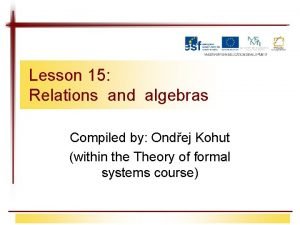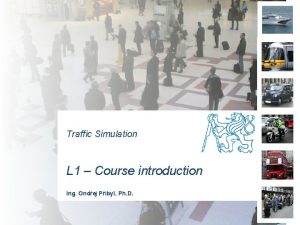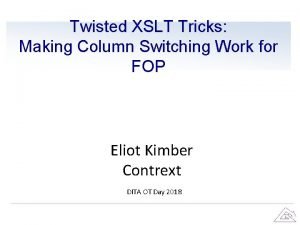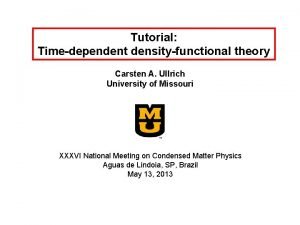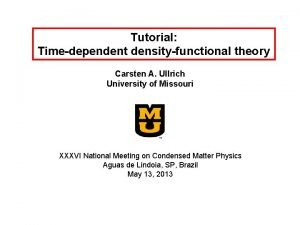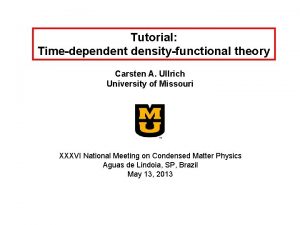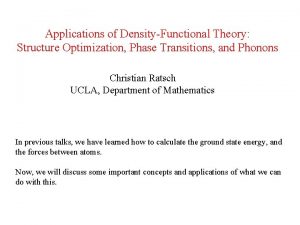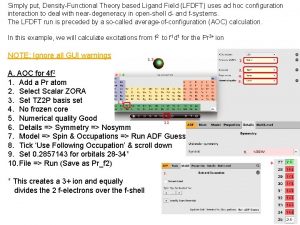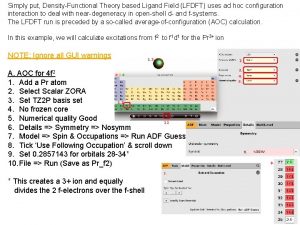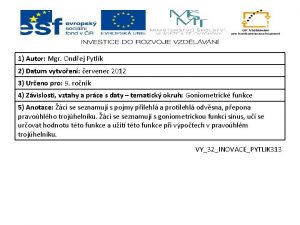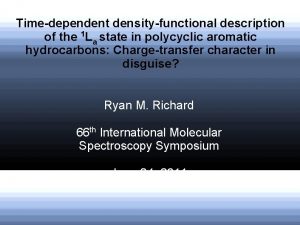DensityFunctional Theory for Practitioners Tutorial 2 Ondej Krej




































- Slides: 36

Density-Functional Theory for Practitioners - Tutorial 2 Ondřej Krejčí, Xi Chen, Milica Todorović and Patrick Rinke Aalto University School of Science Department of Applied Physics

Recap - two minimisations in DFT structure search E 0 total energy minimisation energy of electrons n(r) geometry optimisation {R}

Expansion around the equilibrium E 0 R 0 equilibrium energy R forces are 0 in minimum

Harmonic approximation E 0 R harmonic oscillator: vibrational frequency atomic mass

Vibrational frequencies In general we have to solve a matrix equation: Hessian matrix masses of the atoms vibrational frequencies

Negative frequencies E 0 If we are not in the equilibrium structure, the 2 nd derivative does not give us the vibrational frequency! Imaginary (or negative) frequencies result!

Recap - two minimisations in DFT structure search E 0 total energy minimisation energy of electrons geometry optimisation n(r) How do we actually minimise the total energy? {R}

Let’s go back to the (B-O) full Hamiltonian H( - - - …) - - 1 electron - all electrons -

Let’s go back to the (B-O) full Hamiltonian H( - - - …) - all electrons interact with each other → intractable 1 electron - - all electrons

Non-interacting (electron) Hamiltonian Let’s assume we have a non-interacting system. - -

Non-interacting (electron) Hamiltonian Let’s assume we have a non-interacting system. Electrons move in an auxiliary potential that is the same for all electrons. - -

Non-interacting (electron) Hamiltonian Let’s assume we have a non-interacting system. Electrons move in an auxiliary potential that is the same for all electrons. - -

Non-interacting (electron) Hamiltonian Now we have a mini Schrödinger equation. The same for every electron. This is easy to solve, once we know haux.

The non-interacting wave function Let’s look at only two electrons. The wave function becomes a simple product. But there is a problem!

The non-interacting wave function The wave function is not antisymmetric! Make the wave function antisymmetric! This is called a Slater determinant.

The non-interacting density The density becomes very simple!

DFT - Hohenberg-Kohn theorems Theorem 1: The ground state density n 0(r) uniquely determines the potential up to an arbitrary constant. Walter Kohn Pierre Hohenberg P. Hohenberg and W. Kohn, Phys. Rev. 136, B 864 (1964)

DFT - Kohn-Sham system An auxiliary noninteracting system exists that gives the groundstate density. Walter Kohn Lu Sham W. Kohn and L. J. Sham, Phys. Rev. 140, A 1133 (1965)

DFT - Kohn-Sham system - - - - But what is the auxiliary potential vaux(r)? W. Kohn and L. J. Sham, Phys. Rev. 140, A 1133 (1965)

One part is the external potential - - - e. g. H 2 molecule

Another the electrostatic potential Charge density creates electrostatic potential. W. Kohn and L. J. Sham, Phys. Rev. 140, A 1133 (1965)

Kohn-Sham potential known unknown Now we can solve the Kohn-Sham equations: W. Kohn and L. J. Sham, Phys. Rev. 140, A 1133 (1965)

Kohn-Sham potential vaux(r) In practice: 1. known start with trial densityunknown 2. vaux defined by the density 3. new density via minimization The Kohn-Sham potential depends on the density. 4. Go. To 2 … 5. iterate to self-consistency W. Kohn and L. J. Sham, Phys. Rev. 140, A 1133 (1965)

Kohn-Sham potential vaux(r) FHI-aims technical detail: In practice: 1. known start with trial densityunknown FHI-aims offers 3 convergence criteria for the self-consistency cycle: 2. iterate to self-consistency : tolerance for the density sc_accuracy_rho The Kohn-Sham potential depends on the density. sc_accuracy_etot : tolerance for the total energy sc_accuracy_eev : tolerance for the sum of eigenvalues sc_iter_limit : maximum number of self-consistences steps W. Kohn and L. J. Sham, Phys. Rev. 140, A 1133 (1965)

Kohn-Sham energy known unknown W. Kohn and L. J. Sham, Phys. Rev. 140, A 1133 (1965)

Kohn-Sham energy known unknown • All energies are a functional of the density. • The exchange-correlation (xc) functional: • encompasses all electron-electron interactions beyond Hartree • includes the difference between the noninteracting and the interacting kinetic energy W. Kohn and L. J. Sham, Phys. Rev. 140, A 1133 (1965)

Kohn-Sham energy known unknown What is this haunting Exc? • All energies are a functional of the density. • The exchange-correlation (xc) functional encompasses: • all electron-electron interactions beyond Hartree • the difference between the non-interacting and the interacting kinetic energy W. Kohn and L. J. Sham, Phys. Rev. 140, A 1133 (1965)

The local density approximation (LDA) If we zoom in enough, charge density ≈ constant. W. Kohn and L. J. Sham, Phys. Rev. 140, A 1133 (1965)

The local density approximation (LDA) Constant n(r) = homogenous electron gas (HEG) Let’s make a local approximation: exchange-correlation energy density of HEG W. Kohn and L. J. Sham, Phys. Rev. 140, A 1133 (1965)

The local density approximation (LDA) HEG exchange energy density known analytically HEG correlation energy density known very accurately from Quantum Monte Carlo simulations parameterised efficiently J. Perdew and A. Zunger, Phys. Rev. B 23, 5048 (1981)

The local density approximation (LDA) LDA exchange-correlation potential parameterised efficiently J. Perdew and A. Zunger, Phys. Rev. B 23, 5048 (1981)

Beyond the local density approximation We can incorporate also density-gradients in Exc. LDA and PBE are very efficient xc-functionals. Applicable to ~100 -1000 atoms. The PBE xc-functional is such a generalised gradient approximation (GGA). J. Perdew, K. Burke, and M. Ernzerhof, Phys. Rev. Lett. 77, 3865 (1996)

Basis functions Let’s expand Kohn-Sham states in a basis. Many basis choices: • plane waves or real space • linear augmented plane waves (LAPW) (e. g. WIEN 2 k) • projector augmented plane waves (PAW) (e. g. GPAW, VASP) • local orbitals • Gaussian orbitals (e. g. CP 2 K) • numeric atom centered orbitals (NAOs) (e. g. FHI-AIMS, SIESTA)

Basis functions In FHI-aims: flexible basis function choice radial function spherical harmonic solution of a radial Schrödinger equation:

Real-space grid for basis functions in FHI-aims 1: grid parameters (light, tight, really tight) 2: number basis functions (Tiers)

QUESTIONS ? Practical geometry transfer to your computer will follow afterwards:
 Barbira krej
Barbira krej Barbora krej
Barbora krej Rudy
Rudy Stakeholder classification
Stakeholder classification Ondej
Ondej Ondej
Ondej Ondej
Ondej Ondej
Ondej Ondej
Ondej Introductioning
Introductioning Ondej
Ondej Ondej
Ondej National association of patent practitioners
National association of patent practitioners Mpaf
Mpaf Theatre practitioner meaning
Theatre practitioner meaning Absorption of grade r practitioners 2022
Absorption of grade r practitioners 2022 Software engineering a practitioners approach
Software engineering a practitioners approach Association of independent insolvency practitioners
Association of independent insolvency practitioners Kimber dita for practitioners volume 1 (epub|pdf|mobi)
Kimber dita for practitioners volume 1 (epub|pdf|mobi) Tax practitioners association indore
Tax practitioners association indore Curbside management practitioners guide
Curbside management practitioners guide Unregistered health practitioners
Unregistered health practitioners Social business practitioners
Social business practitioners Australian college of nurse practitioners
Australian college of nurse practitioners Fspos
Fspos Typiska novell drag
Typiska novell drag Tack för att ni lyssnade bild
Tack för att ni lyssnade bild Returpilarna
Returpilarna Shingelfrisyren
Shingelfrisyren En lathund för arbete med kontinuitetshantering
En lathund för arbete med kontinuitetshantering Kassaregister ideell förening
Kassaregister ideell förening Personlig tidbok fylla i
Personlig tidbok fylla i Anatomi organ reproduksi
Anatomi organ reproduksi Vad är densitet
Vad är densitet Datorkunskap för nybörjare
Datorkunskap för nybörjare Boverket ka
Boverket ka Debattartikel struktur
Debattartikel struktur




